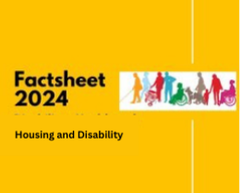Housing and Disability
Issued on December 20 2024
Social Housing
- 5,289 households on the social housing waiting list have named disability as the main category of need. This is 9% of all households on the waiting list.[8]
- On average, about 20% more applicants with a disability-related housing need have social welfare as their only income source. These applicants are also about 3.5 times less likely to be employed.[9]
- Between 2016-2020, the number of people on the housing list reduced by almost 33%. But the number of people with a disability basis of need reduced by just 12% over the same period.[10]
- Between 2016 – 2020, the median waiting time for those with a disability need increased from 4 years to 4.7 years, whereas the median waiting time for all households reduced from 3.8 years to 3.4 years.[11]
Communal Living and Decongregation
- 4% (46,552) of the disabled population live in a communal establishment.[12]
- 8% of all people living in communal establishments have a disability. 69% (32,121) of disabled people living in communal establishments have a disability to a great extent.[13]
- 1,228 people with disabilities aged under 65 live in nursing homes.[14]
- 2,279 people with disabilities live in congregated settings.[15]
- In 2023, 70 people transitioned from congregated settings to homes in the community (the 2023 target was 73).[16] The original timeline for ending the practice of people living in congregated settings was 2018.
[1] United Nations Article 19 – Living independently and being included in the community
[2] United Nations Article 28- Adequate standard of living and social protection
[3] NDA (2024) NDA Factsheet 5: Housing and accommodation circumstances of disabled people
[4] Ibid.
[5] CSO (2023) People with a disability in private households; Persons with a Disability as a Percentage of All Population. This percentage is calculated with reference to the overall number of people with a disability to any extent (1,109,557)
[6] IHREC & ESRI (2018) Discrimination and Inequality in Housing in Ireland, pg.46.
[7] Census (2023) Census of the Population 2022
[8] The Housing Agency (2024) Summary of Social Housing Assessments 2023
[9] The Housing Agency (2021) Analysis of Households with a Disability Basis of Need for Social Housing 2016 – 2020, pg.13.
[10] Ibid., pg.5
[11] Ibid., pg.16
[12] CSO (2023) People with a disability Note: communal establishment refers to managed residential accommodation. This includes nursing homes, hospitals, shelters, religious communities, and prisons.
[13] NDA (2024) NDA Factsheet 5: Housing and accommodation circumstances of disabled people
[14] Nursing Home Support Scheme (Fair Deal) data as of November 2023
[15] HIQA (2023) Disability Overview Report 2022, pg. 11. Note: a congregated setting is where 10 or more people with a disability are housed in a single living unit or placed in accommodation that is campus or institution based - Time to Move On from Congregated Settings - HSE.ie
[16] Department of Public Expenditure NDP delivery and Reform (2023) Public Service Performance Report 2023 (www.gov.ie), pg. 39.

